

Earth Floor: Biomes. Tropical Savannah The tropical savanna is a biome characterized by tall grasses and occasional trees.
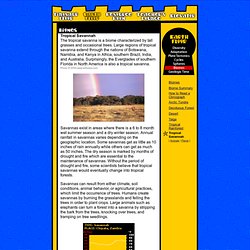
Large regions of tropical savanna extend through the nations of Botswana, Namibia, and Kenya in Africa, southern Brazil, India, and Australia. Surprisingly, the Everglades of southern Florida in North America is also a tropical savanna. Photo © 2000-www.arttoday.com Savannas exist in areas where there is a 6 to 8 month wet summer season and a dry winter season. Annual rainfall in savannas varies depending on the geographic location. Savannas can result from either climate, soil conditions, animal behavior, or agricultural practices, which limit the occurrence of trees. Back | Next. Tropical Savanna Biome: Video Resource. Savannas are the tropical version of the temperate grasslands.

Most savannas are caused by climatic patterns where there is a strong dry season for a large part of the year. Few trees survive in these regions, but most savannas do have some form of trees that scatter the landscape. If you look at the map below you'll realize that a large part of Africa, nearly half its landmass, is covered in some sort of savanna. Large tracks of savanna are also found in South America, India and Australia. Climate: The annual rainfall in a savanna is from 50.8 to 127 cm of rain a year (20-50 inches). Soils: Certain savannas are caused because of shallow or clayish soils. Most savanna soils however, are very porous and have only a very thin layer of organic matter. Vegetation In any one savanna the vegetation consists primarily of grasses and small forbes (such as wildflowers that grow with the grasses). Animals. What is AFRICA SAVANNA LANDFORMS? Plains, mountains and the valleys between them are all landforms.

The savanna itself is a landform. But within it, ... What Are the Major Landforms of East Africa? East Africa is marked by several distinct and dramatic landforms, ... Ads. KDE Santa Barbara. Welcome to the Kids Do Ecology Biomes Pages!

Aquatic Biomes | Terrestrial Biomes | GAMES! What are biomes? Biomes are regions of the world with similar climate (weather, temperature) animals and plants. There are terrestrial biomes (land) and aquatic biomes, both freshwater and marine. Would you like to know what the weather is like in different biomes around the world? How many biomes are there? Games Links to more information: Kids Konnect: Biomes Enchanted Learning: Biomes. Savanna. From New World Encyclopedia A savanna or savannah is a tropical or subtropical woodland ecosystem characterized by the trees being sufficiently small or widely spaced so that the canopy does not close, above a continuous tall grass understory.
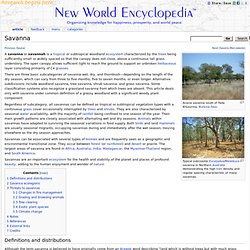
The open canopy allows sufficient light to reach the ground to support an unbroken herbaceous layer consisting primarily of C4 grasses. There are three basic subcategories of savanna-wet, dry, and thornbush—depending on the length of the dry season, which can vary from three to five months, five to seven months, or even longer. Savanna Biome. The savanna, in lamenst terms, is a tropical grassland with some clumps of trees. The Savanna is charecterized by the wet and dry season, specific to the Savanna.
In the Savanna, despite the harsh "dry season", animals and plants prosper. Average Annual Rainfall- 59 in. Savanna Biome. When we think of the Savanna Biome, it is understandable that we think of hot and dry areas.
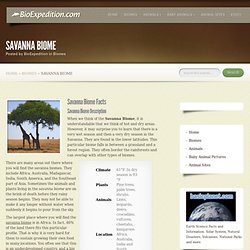
However, it may surprise you to learn that there is a very wet season and then a very dry season in the Savanna. They are found in the lower latitudes. This particular biome falls in between a grassland and a forest region. They often border the rainforests and can overlap with other types of biomes. Savanna Biome Facts. Savanna refers to the tropical grassland biome, which extends over large areas.

The term itself is derived from the Arawak word for 'treeless lands having grasses'. It is known by varied local names in different regions: the Savannah in Africa, Prairie in North America, Rangelands in Australia and Steppes in Asia. Savanna Animal Printouts. Savanna Animals. Savanna Biome Facts. Savanna Biomes. A savanna is a rolling grassland scattered with shrubs and isolated trees, which can be found between a tropical rainforest and desert biome.

Not enough rain falls on a savanna to support forests. Savanna Climates. Australian Tropical Savanna Climate Wet-Dry Tropical Climates (Aw) The Australian Savanna is characterized by two very different seasons: the "wet" and the "dry".
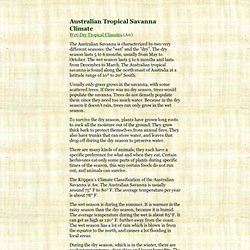
The dry season lasts 5 to 6 months, usually from May to October. The wet season lasts 5 to 6 months and lasts from December to March. Science for Kids: Savanna Grasslands Biome. The savanna is a type of grasslands biome.
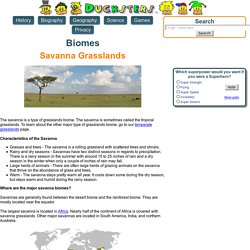
The savanna is sometimes called the tropical grasslands. To learn about the other major type of grasslands biome, go to our temperate grasslands page. Science for Kids: Savanna Grasslands Biome. The grassland biome. Online exhibits : The world's biomes The grassland biome Grasslands are characterized as lands dominated by grasses rather than large shrubs or trees. In the Miocene and Pliocene Epochs, which spanned a period of about 25 million years, mountains rose in western North America and created a continental climate favorable to grasslands. Ancient forests declined and grasslands became widespread. Following the Pleistocene Ice Ages, grasslands expanded in range as hotter and drier climates prevailed worldwide.